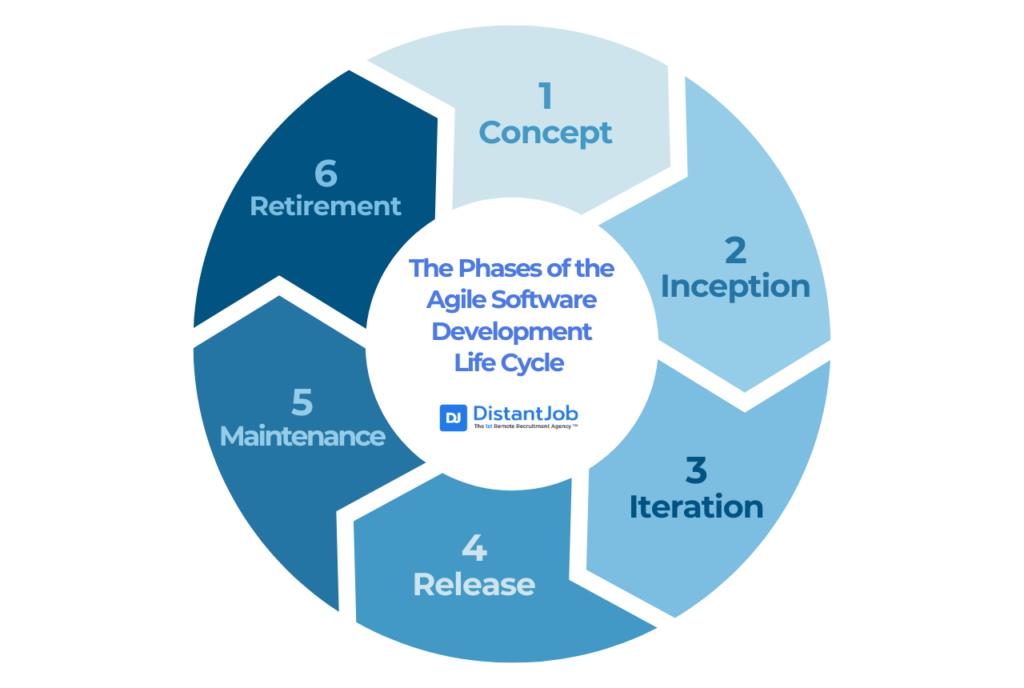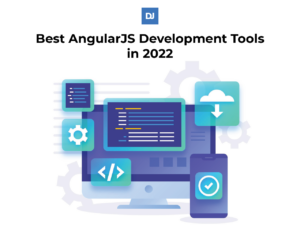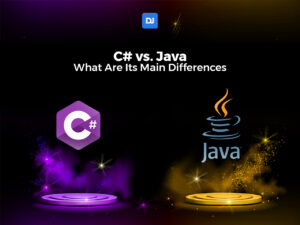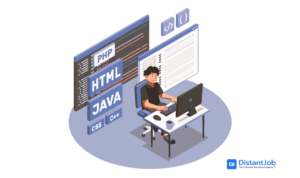The Agile Software Development Life Cycle (SDLC) is an iterative approach to software development focusing on flexibility, collaboration, customer feedback, and rapid delivery of functional software. Originating in the early 2000s from a meeting of seventeen talented developers who were tired of suffering from traditional project management methods, Agile was born from their collective experiences and experiments in the 1990s, leading to methodologies like Scrum, Extreme Programming (XP), and Adaptive Software Development (ASD).
Together, they published the Manifesto for Agile Software Development. The main ideas behind the methodology are:
- Individuals and interactions over processes and tools
- Working software over comprehensive documentation
- Customer collaboration over contract negotiation
- Responding to change over following a plan.
The Agile SDLC consists of the following key phases:
- Concept/Inception: Clearly defining the vision, scope, and goals of the project.
- Iteration/Development: Breaking the project into small, manageable increments (iterations), allowing for continuous development, feedback, and improvements.
- Release/Testing: Regular testing and review sessions to ensure quality and functionality meet customer expectations.
- Deployment/Delivery: Frequent delivery of working software to users, enabling immediate value and regular feedback.
- Review and Maintenance: Ongoing assessment, iteration, and maintenance to continually enhance and adapt the software according to evolving needs and user feedback.
- Retirement phase
Benefits of Adopting Agile Methodologies
The Agile methodology is known for its flexibility and ability to adapt to changing project requirements. Its impact will vary from case to case because each team has unique needs and challenges.
However, these are the perks that most teams experience when adopting Agile practices.

Superior Quality Product
Testing is an integral component of project execution in Agile project management. This means the overall quality of the product is better. During the development process, the client remains involved and can ask for changes based on the realities of the market. Self-organizing teams continuously learn and grow with Agile because it is an iterative process.
Satisfied Customers
Stakeholders want to be involved throughout the project life cycle so they can provide feedback and ensure the final product meets their expectations. By adopting an Agile methodology, organizations can keep customers in the loop and show that they value their opinions.
Improved Predictability
Agile teams work in short periods, often called sprints. These sprints (usually two weeks) allow project managers to easily evaluate performance and allocate resources accordingly. It also makes predicting costs for shorter periods easier than for long-term projects, which simplifies estimation.
Increased Flexibility
Adaptability is a cornerstone of agile methodologies. Agile teams can quickly adjust priorities and change course without disruption. Project deliverables are not set in stone, giving teams the freedom to pivot based on updated requirements. Being flexible means teams can deliver consistently and adapt to changes throughout the project lifecycle.
The Phases of the Agile Software Development Life Cycle

The Agile software development life cycle consists of six stages: concept, inception, iteration, release, maintenance, and retirement. Let’s explain them in detail.
1. Concept
In this phase, the product owner will define the scope of a project. There are two types of scopes: product and project.
The product scope is defined as the functions or features that characterize a product or service. In contrast, the project scope is work that needs to be done in order to deliver a product or service according to the product scope.
During this stage, the product owner and the client will discuss the key requirements that need to be included in the product or service. These requirements will then be included in the documentation.
With the classic Waterfall model, you would write extensive documentation detailing all the features and functions. But this isn’t the case with the Agile methodology. You are only required to write the minimum documentation because the focus is on working software rather than comprehensive documentation. Plus, you can always edit the documentation at the latest stage.
The product owner will also define the business opportunity and the time required to complete the project. It is also important for the product owner to understand the problems they are trying to solve for the end user. When they understand these challenges or needs, they can better prioritize functions and features to solve these problems.
After all, the whole point is to build something that the users will want to use.
For example, let’s say you’re building a productivity app. During the concept phase, the team might identify key features such as task management, calendar integration, and reminder notifications. These features would then be prioritized to meet the user’s immediate needs.
2. Inception
The goal of this stage is to do just enough work to get your team going in the right direction.
Here, the team should be ready to experiment and start building prototypes based on the requirements agreed upon in the previous phase.
The product owner’s first task is to build the best team possible. This includes developers, testers, designers, and other relevant stakeholders who can contribute to the project’s success. Then, everyone needs to collaborate to build a mock-up or prototype and give it to the client to gather feedback—the more feedback, the better.
The goal is to build the best possible application in terms of value for the customer. This happens through constant feedback and incremental improvements till the final product meets the customer’s needs.
Going back to our productivity app example, the team will build a prototype that clients can interact with to test its functionality. Then, they can give feedback about the features they’d like to see implemented or changed.
For example, one client might suggest adding a calendar feature to track deadlines better, while another might prefer a dark mode option for working at night without straining their eyes.
3. Iteration
This is the stage where we actually build the application, which will be released to customers later. The whole team, including the product owner, will work together to convert these requirements—the mock-up that was previously created—into a functional software product.
Here’s the thing: It doesn’t have to be a full-fledged application with all the bells and whistles right away. The aim is to get a version of the product into customers’ hands as soon as possible to gather feedback and iterate based on real-world usage.
Using our productivity app example, we will release a basic version with core features like task management and reminders. This initial release allows the team to gather feedback from beta users on how they interact with the app and what features they find most useful. Based on this feedback, the team can prioritize enhancements and new features for future iterations.
One thing to keep in mind in this phase is the problem you defined in the concept phase—the user challenges you were trying to address.
4. Release
You are now ready to release your application. This could be the next iteration—the release iteration. You have written and tested the code and ensured the requirements and defined criteria have been met. The beta testers liked the product, so you are confident it is ready for public launch.
In this phase, you need to ensure that the production environment is set up and stable. You will test the code and functionalities to ensure that everything is working as expected.
This step also includes testing and debugging, which may result in bug defects that the development team needs to fix before release.
Once you’ve fixed all the bugs (the critical ones, at least) and are ready to deploy the application to production, you need to ensure it has documentation. Customers need to be able to navigate through a tutorial or reference guide to use the application.
Once all these things are in check, you can finally deploy to production.
Congratulations! Your application is now released. But this is not the final version—far from that. You’ve released the minimum application version you could put on the market to satisfy the customer.
Now, it’s time to get feedback from customers so that you can prepare the next version of the software, which takes us to the next phase: maintenance.
5. Maintenance
After the application is finally in production, the team then continues support for any bugs that may be found. Often, because of edge cases, some bugs are found after production and may have been missed during testing. That’s okay; it happens in every application.
The point of testing is to minimize bugs, so you may not catch all of them. New bugs should be addressed and communicated to the team and prioritized for future sprints and releases.
6. Retirement
In the retirement phase, the product or feature is either obsolete or being replaced by something else. The software development team will first notify users about the product’s retirement and guide them through the transition to a new solution if one is available.
Finally, the developers archive data, shut down servers and document the process for future use in order to retire the product or feature.
Agile Methodologies and Frameworks
Among the popular Agile methodologies and frameworks include:
- Scrum: The most widely used framework, Scrum emphasizes iterative development in short cycles called sprints. It involves cross-functional teams, specific roles (Product Owner, Scrum Master, Developers), and artifacts (product backlog, sprint backlog, increment).
- Kanban: A visual approach that focuses on continuous workflow. Work items are represented by cards on a Kanban board, with limits on the number of ongoing tasks to optimize efficiency. Kanban is flexible and adaptable to different project needs.
- Extreme Programming (XP): A perspective framework that is based on close collaboration between developers and customers. It incorporates practices like pair programming, test-driven development, and continuous integration to deliver high-quality software.
- Feature-Driven Development (FDD): An iterative and incremental Agile methodology that focuses on delivering working software in short cycles with a strong emphasis on client involvement. It breaks down projects into manageable features and prioritizes them based on client output.
- Crystal: A family of lightweight Agile frameworks that prioritize simplicity, communication, and empowerment of teams. Different Crystal variations are tailored for teams of various sizes, with Crystal Clear for small teams (up to 8 people) and Crystal Orange for large teams (up to 1000 people).
- Lean Development: Focuses on seven fundamental principles: Deleting the things that do not matter, quality development, creating knowledge, differing commitments, fast delivery, respecting the team, and optimizing the whole.
How to Implement Agile SDLC In Your Organization
If you have decided to adopt the Agile software development methodology, here are some things to know to set your team up for success:
Assess Your Current Processes
The first step to implementing the Agile SDLC in your organization is understanding your readiness for the change. That means evaluating your current processes, identifying opportunities for improvement, and your culture.
Then, you need to establish your goals, objectives, and metrics for scaling Agile SDLC and communicate them to stakeholders. You also need to evaluate the complexity and interdependence of your projects.
Choose the Right Agile Framework
Once you have the information about your project, it’s time to select the Agile framework. There are many options, including the ones covered above. Before you choose, consider your development team’s process, size, goals, and needs.
For instance, if you want speed and adaptability on a small scale, Scrum may be the right framework. Kanban may be a good choice if your team is accustomed to boards. ScrumBan, a combination of Scrum and Kanban, is already gaining popularity.
Get Your Team Onboard
A successful implementation requires buy-in from all team members.
You can accomplish this by making the process easy to understand for stakeholders and straightforward for developers and other members of the team.
That’s where educating internal and external stakeholders about the benefits of Agile comes in. This training ensures everyone is on the same page.
Conduct Daily Standups
A daily standup meeting is typical of any Agile project. The main goal of this meeting is to discuss progress and identify blockers. Each team member can share what they worked on the previous day, what they plan to work on today, and any challenges they face.
With everyone sharing their challenges, you can work together to find solutions and avoid roadblocks in the project.
Monitor and Improve Performance
After completing a sprint, you need to take stock of the successes and failures. Gather and analyze data on your key performance indicators (KPIs), such as completion rates, user engagement, and project timelines.
Also, you need to collect and act on feedback from customers, stakeholders, and teams to continuously enhance your processes and outcomes.
In addition, you need to conduct regular retrospectives and reviews to evaluate the effectiveness of your strategies and identify areas for improvement.
Conclusion
Agile is characterized by having an iterative process. This helps teams work in a detail-oriented approach, focusing on delivering working software to users as fast as possible.
But is the Agile SDLC a fit for your team? It depends on the nature of your projects, team dynamics, and organizational culture.
For example, a lack of experience and buy-in from key stakeholders can hinder the successful implementation of the Agile SDLC. Projects with well-defined requirements may also not fully benefit from the Agile SDLC, as its iterative nature thrives on adapting to changing requirements.
Understand your team’s strengths and weaknesses to determine if the Agile SDLC is the right approach for your projects.
Whether or not you decide to adopt the Agile SDLC, you need the right development team.
The good news is that we’re here to help you deliver the best software with the best team. At DistantJob, we are experts in understanding our client’s needs and helping them hire elite remote software developers who fulfill (and exceed) their expectations. Interested? Speak with our team!





